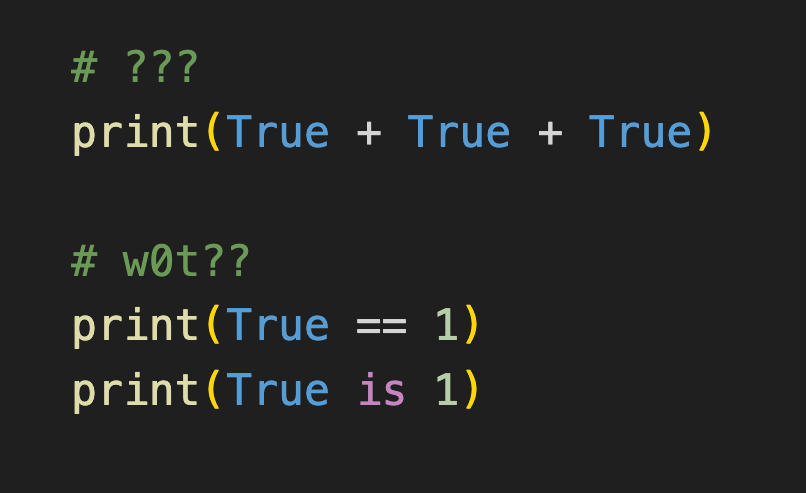Surprising Insights into Python Boolean Values: Equality, Addition, and Unexpected Behavior
Core Concepts
Python's boolean values exhibit some surprising and unintuitive behaviors, including equality comparisons with integers and the ability to add True values together.
Abstract
The author recently learned two interesting quirks about Python boolean values:
-
Equality Comparison with Integers:
- The boolean values
TrueandFalseare equal to the integer values1and0respectively when using the==operator. - However, when using the
isoperator,Trueis not the same object as1, andFalseis not the same as0. - This distinction is due to the difference between checking for value equality (
==) and object identity (is).
- The boolean values
-
Adding True Values:
- Since
Trueis equal to1, the author discovered that you can addTruevalues together like integers. - This can be useful for quickly counting the number of
Truevalues in a list, as demonstrated by the example:ls = [True, True, False, True, False, False, True, False] print(sum(ls)) # Output: 4
- Since
The author finds these behaviors both strange and entertaining, and suggests readers check out their Substack post for more cool Python boolean-related insights.
Customize Summary
Rewrite with AI
Generate Citations
Translate Source
To Another Language
Generate MindMap
from source content
Visit Source
levelup.gitconnected.com
I Recently Learn 2 Strange Things About Python Boolean Values
Stats
True == 1
False == 0
True + True == 2
True + True + True == 3
True + True + True + True == 4
Quotes
"Very strange and interesting. But it kinda does make sense I guess?"
"Unintuitive and strange behaviour, but entertaining in some way."
Key Insights Distilled From
by Liu Zuo Lin at levelup.gitconnected.com 07-21-2024
https://levelup.gitconnected.com/i-recently-learn-2-strange-things-about-python-boolean-values-8e44f1e5735e
Deeper Inquiries
What are the potential use cases or practical applications of being able to add True values together in Python
The ability to add True values together in Python can have practical applications in scenarios where boolean values are used to represent numerical quantities or states. One potential use case is in counting the occurrences of True values in a list or array. By treating True as equivalent to the integer 1, developers can easily sum up the boolean values to obtain a count of true conditions. This can be particularly useful when dealing with boolean masks, filtering data, or performing calculations based on boolean conditions. Additionally, this feature can simplify code and make it more concise when working with boolean logic that involves counting or aggregating true values.
How might the equality comparison behavior between booleans and integers be leveraged or cause unexpected issues in larger Python codebases
The equality comparison behavior between booleans and integers in Python, where True == 1 and False == 0, can be leveraged in certain situations but may also lead to unexpected issues in larger codebases. While this behavior can be useful for simplifying comparisons and calculations involving boolean and numerical values, it can potentially introduce subtle bugs or errors if not handled carefully. In complex codebases, where different parts of the codebase may rely on the strict distinction between boolean and integer values, relying on the implicit conversion between them can lead to confusion and unintended consequences. Developers should be cautious when mixing boolean and integer values in comparisons and ensure that the codebase maintains consistency in how boolean values are treated in different contexts.
What other unexpected or counterintuitive behaviors exist in Python's handling of boolean values, and how can developers best navigate and account for them
Python's handling of boolean values exhibits several unexpected or counterintuitive behaviors that developers should be aware of to write robust and reliable code. One such behavior is the difference between using the == operator and the is operator when comparing boolean values to integers. While True == 1 evaluates to True, True is 1 evaluates to False due to the distinction between value equality and object identity. Another counterintuitive behavior is the ability to perform arithmetic operations on boolean values, such as adding True values together. While this feature can be entertaining and occasionally useful, it may lead to confusion if not used judiciously.
To navigate and account for these unexpected behaviors, developers should prioritize clarity and consistency in their code. It is essential to document any non-standard or unconventional use of boolean values to ensure that other developers can understand the code's logic. Additionally, developers should be cautious when relying on implicit conversions between boolean and numerical values, as this can lead to subtle bugs and errors. By maintaining a clear and consistent coding style, developers can mitigate the risks associated with Python's quirky handling of boolean values.
0
